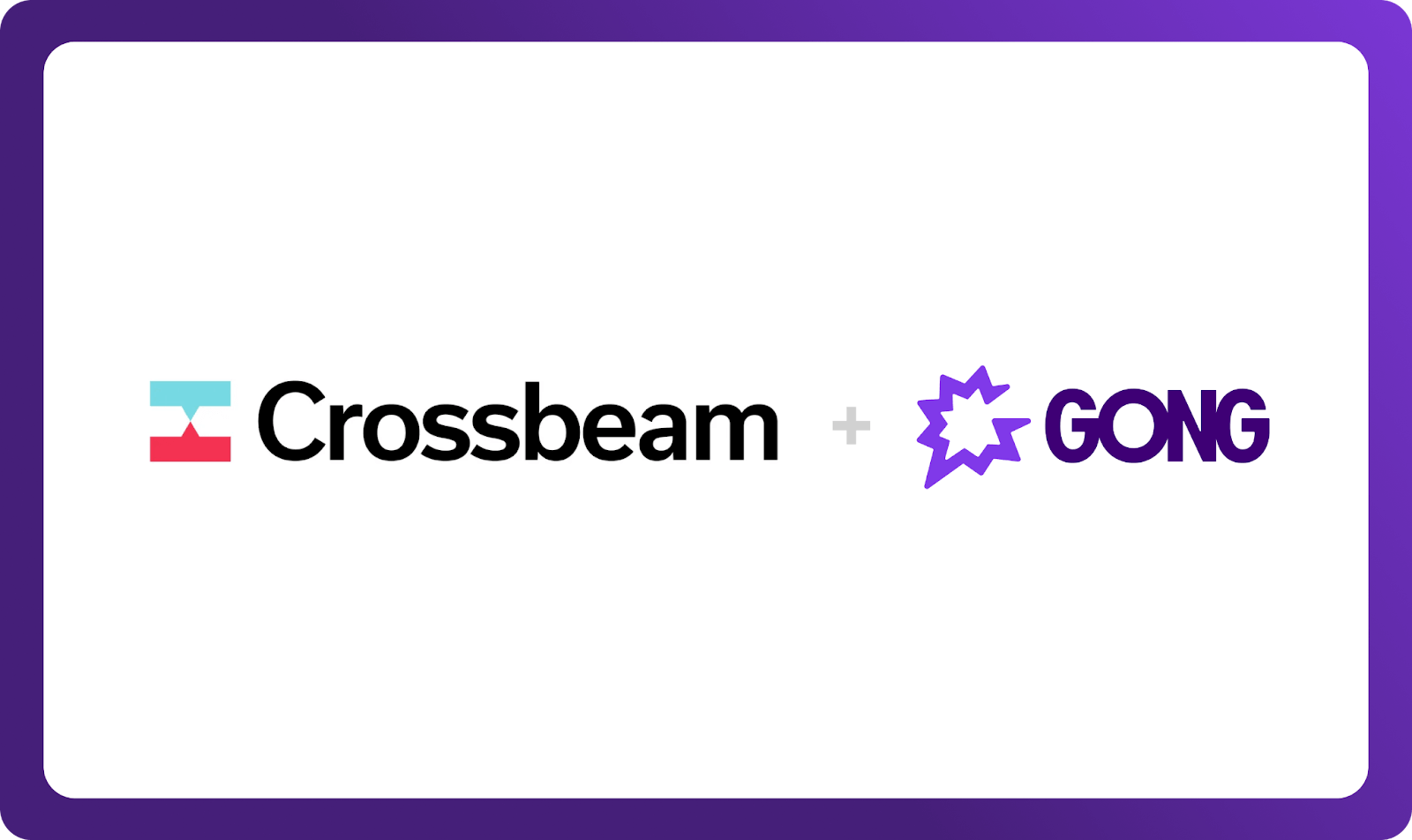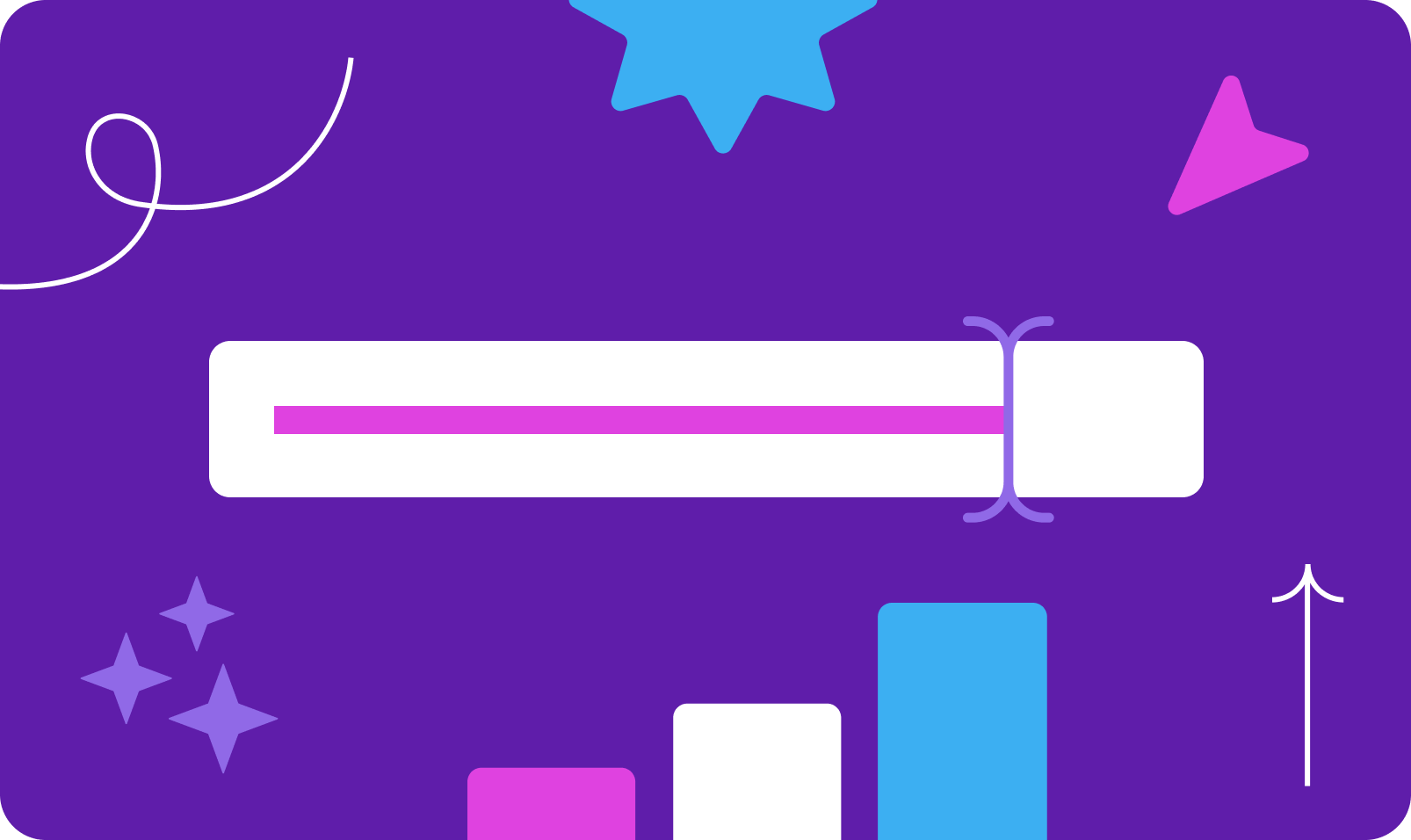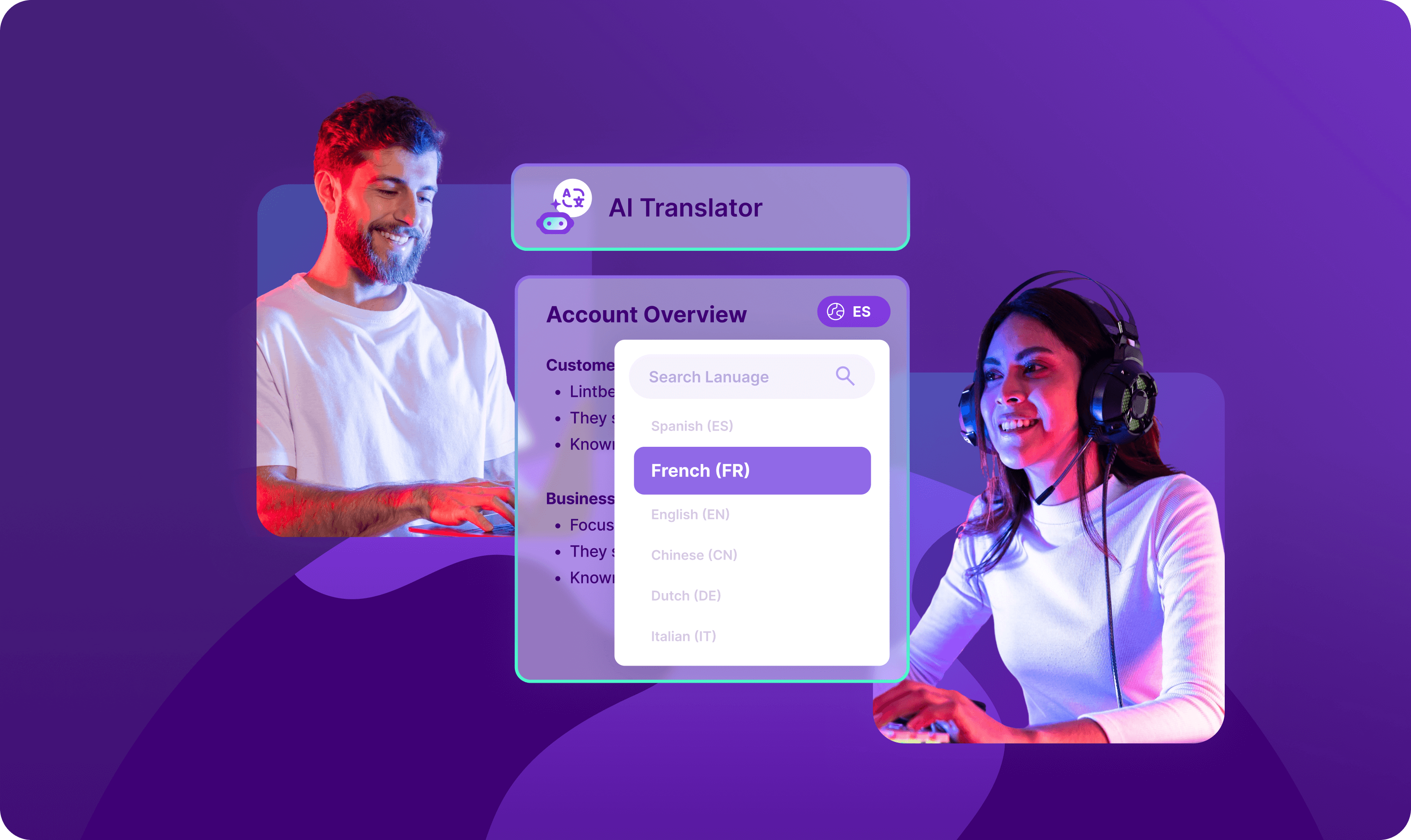Sales strategies
Ecosystem-led growth: How revenue teams win bigger with Gong + Crossbeam

Patrick Burke
Sr. Manager, GTM Partnerships
Published on: May 16, 2025

The pressure is on: Why traditional GTM motions aren’t enough
Revenue leaders are underimmensepressure to hit bigger targets with fewer resources. But cold outreach is getting colder and inbound channels are saturated. Product-led motions — while scalable — don’t always translate into predictable pipeline at the enterprise level.
What’s the solution? It isn’t more hustle. It’s smarter alignment. The best-performing sales organizations aren’t just dialing more, they’re tapping into trusted networks to move their deals forward. That’s an approach known asecosystem-led growth (ELG).
Ecosystem-led growth is emerging as the next frontier in go-to-market (GTM) strategy. It enables revenue teams to move faster, engage buyers more strategically, and win bigger deals. And it’s based on leveraging the partners and integrations their prospects already know and trust.
In this article, we break down the ELG framework and explain how it differs from other growth models. We also how two SaaS companies,Gong + Crossbeam, are unlocking real-world value for sales teams that adopt an ELG approach as part of their growth strategy.
For starters, whatisyour ecosystem?
Everyone inside your sales organization — from SDRs to CEOs — is part of your daily, internal ecosystem. Whether they’re sales reps at a global brand or co-founders at startups, they’re trusted allies.
Externally, your ecosystem can include technology partners, resellers, system integrators, consultants, and more. It also includes your customer base, industry influencers, and thought leaders. Connections you make when you participate in industry events also become part of your external ecosystem. They’re all candidates for engaging in strategic partnerships, or forming loose “partnership teams.”
Everyone in your internal and external professional world is part of your work ecosystem.
What then, is ecosystem-led growth?
ELG defined
In short, ELG is about the selling power of partnerships.
You have the ability to transform everyone in your ecosystem into potential advocates and collaborators — even new customers! That’s true whether you work at small startups or global behemoths.
Ecosystem-led growth (ELG)is a revenue strategy that relies onpartnerships, integrations, and customer relationshipsto fuel pipeline expansion and revenue growth.
That may not sound revolutionary, but the “power of partnerships” isn’t addressed in traditional go-to-market (GTM) sales models. Traditional models rely on siloed execution:
- Sales-led growth (SLG)depends on outbound prospecting and direct selling.
- Product-led growth (PLG)relies on the product to drive adoption and expansion.
Ecosystem-led growth (ELG), on the other hand, engages external networks —partners, integrations, and co-sellers— to accelerate every stage of the sales cycle.
ELG shifts the GTM model away from isolated sales motions where people in each part of the sales process work on their own. It moves them all toward collaborative, insight-driven plays made by the entire revenue team — from business development through to customer success. And, as you’ve likely guessed, a good ELG strategy extendsoutsideyour organization.
Done right, ELG is a revenue multiplier. It means your teams’ playbooks are aligned from the moment you begin onboarding new hires. Plus, it primes everyone to make the most of their professional network — orecosystem.
Why it matters now
B2B buyers are harder to reach. Sales cycles are longer. Customer experience matters more than ever. And trust is hard to come by.
ELG flips the traditional selling equation on its head. Instead of conducting cold outreach, you get awarm introductionfrom a partner your buyer already trusts. Instead of pitching a point solution, you offer aconnected ecosystemthat solves bigger business problems.
In fact, according to the State of Partner Sales report by HubSpot, Crossbeam, and Partnership Leaders, sales leaders using ELG see a measurable boost in pipeline creation. And the Future of Revenue Report shows that ELG also drives stronger GTM alignment, increasing conversion velocity across the board.
Why ELG is a game-changer for revenue teams
Warm intros replace cold outreach
Partner referrals eliminate the biggest barrier in B2B sales: skepticism. When a trusted partner introduces your solution, you start the conversation with instant credibility. That leads to several key benefits:
- Faster deal velocity: Partner-sourced opportunities convert faster than cold leads. You don’t have to spend as much time getting your foot in the door or gaining trust. It’s like starting a deal on second or third base.
- Pre-qualified prospects: Ecosystem-qualified leads (EQLs) often have clearer intent, budget, and timeline. When someone’s willing to recommend you into an organization, it’s because it’s already perceived as a good match. There’s usually a clear issue that your partners know your product can solve.
- Joint solutions = less friction: Co-selling with integration partners simplifies the buying process. Here’s how: When companies offer a joint solution, they’ve often pre-integrated their products or services. This means the customer doesn’t have to figure out how to make disparate systems work together. This provides a more complete, out-of-the-box value proposition, reducing the customer’s integration effort and risk.
Bigger deal sizes, better retention
Buyers don’t want siloed tools, they want solutions that work together. When you sell as a package, you not only raise the average contract value, you also improve adoption and reduce churn.
- Bundled solutions = higher ACV: Joint offerings lead to larger initial deals. That’s because big companies don’t want separate, disconnected programs. They need their platforms (and teams!) to talk to each other to run smoothly. Selling a package deal means customers will use it more often and stick with it longer … and you’ll make bigger sales.
- Ecosystem stickiness: Customers using connected tools are less likely to churn, and integrations with existing tech are a top priority for 76% of buyers (E&Y). That’s because they’ll get better outcomes and have a smoother experience using connected solutions. It’s also tough to move away from a system that’s deeply embedded across their business — one that touches numerous key operations.
- Cross-selling and upselling made easier: Integration value creates natural expansion paths. Once customers see how well your integrated programs work, they’re more open to buying more from you. Adding new parts to a system that’s already connected is easier than starting from scratch.
Built-in market expansion
With ELG, tapping new verticals or regions doesn’t require a ground-up strategy. Your partners already have the trust and access you need.
- Vertical growth: Partnering with niche providers opens industry-specific doors. This can significantly reduce the time and resources required for market entry. This shortcut allows you to bypass the initial, often costly, stages of building brand awareness and trust.
- Geographic scale: Regional partners accelerate global expansion. Regional partners possess invaluable local knowledge, including cultural nuances, regulatory landscapes, and established business networks, which are crucial for navigating international markets. This on-the-ground knowledge can keep your company from making very expensive mistakes. By collaborating with these partners, you can overcome logistical challenges and minimize the risks associated with entering new geographic territories.
- Smarter strategy: partner data helps identify which markets are primed for growth. It can provide valuable insights into emerging market trends, customer demands, and competitive landscapes. Your company will be able to cut down on the guesswork involved in “big bets.” Analyze the data at your disposal to identify high-potential markets, tailor your offerings to regional needs, and optimize your go-to-market strategies.
ELG in action: Gong + Crossbeam
Let’s see how our Gong + Crossbeam partnership has changed what’s possible in terms of your ELG strategies! Together, we’re going to help you take ELG from theory into the real world to create a stronger pipeline. Here’s a quick recap of the two platforms involved in this partnership:
- Gong’s Revenue AI Platform, gives you deep visibility intofirst-partyinteractions. That’s calls, web, emails, and engagement signals across your accounts.
- Crossbeam, the ecosystem intelligence platform, shows yousecond-partyinsights — who your partners know, and where those overlaps exist.
When you combine Gong + Crossbeam, you unlock powerful, data-backed, co-selling motions. How? Through crucial account mapping and more.
Let’s break down a few use cases.
Use case 1: Find high-quality leads your AEs can actually close
One of the biggest challenges in outbound is knowing who to prioritize. Together, Gong + Crossbeam make that selection process easy.
Crossbeam surfaces accounts where your partners are already engaged. Maybe they’re customers of your integration partner, or they’ve attended a co-branded webinar. That’s how you get your foot in the door.
Then Gong layers in real-time engagement insights to prioritize the right plays. Are the recipients opening your emails? Did the champion just forward your deck? With the Gong + Crossbeam partnership, you’ll know.
Why it works:
- Ecosystem-sourced leads (EQLs) convert 53% faster than traditional outbound
- Prioritized target lists meanless outreach spray and more deals that move forward.
Use case 2: Get to closed-won — faster
Gong + Crossbeam helps you accelerate sales cycles by zeroing in on the right stakeholders and surfacing the best partner to bring in.
Gong Engage shows you who to contact, when to reach out, and how to personalize your pitch. Crossbeam then reveals partner activity — who’s in the account, and who can give you an introduction. CRM-integrated workflows make the whole process of co-selling seamless.
With the Crossbeam and Gong Engage integration, your field teams or partner teams can initiate messaging and collaboration from the Crossbeam Co-Pilot experience directly from within Gong. This means capturing the intel from partners about the accounts you’re trying to break into can be accomplished without ever leaving the Gong UI.
Imagine being able to get the answers to the test – how your prospect buys, their timelines, the potholes, all from the partners that have gone down the road before you. What would that give you the power to do?
Why it works:
- Deals close 46% faster.
- ACV increases by 48% when partners are involved in the motion.
Use case 3: Optimize your sales team for ecosystem execution
Not all reps are equal when it comes to partner-led selling. Some have a great track record of landing deals with a specific partner. Others thrive in certain verticals.
Gong + Crossbeam helps youoperationalize those insights.You’ll be able to get key metrics in just a few clicks, then strategize accordingly. That means you can:
- Track rep engagement and performance against Ecosystem Qualified Accounts
- Build real-time notifications and reporting to understand when partners in your ecosystem are engaging, and winning, in the accounts you care most about.
- Use keyword detection to initiate partner-collaboration or involve partners in deals proactively.
- Arm front-line managers with “partner-presence” data for pipeline reviews.
Why it works:
- Understanding what’s happening with your most important accounts allow for a new lens on intent and account prioritization
- Sales leaders can scale what’s working and coach what’s not. Partnerships offer a new source of information to more deeply understand the paper and buying process and timelines
Use case 4: Turn renewals into revenue
Retention is critical. Expansion is even better. Gong + Crossbeam helps CSMs and AMsspot upsell plays early.
Crossbeam surfaces signals like a new tool that’s added to the customer’s tech stack that integrates with your product. Or it might pick up on a mutual partner launching a new initiative.
Meanwhile, Gong captures usage trends and uses revenue insights to inform its insights around timing and messaging.
Why it works:
- Customers with integrations reported 92% lower churn rates than those who didn’t.
- Ecosystem expansion plays help yougrow your accounts before they go cold.
Core components of a successful ELG strategy
The most successful ELG strategies are built on three pillars:
1. Aligned incentives and accountability
Partnerships thrive when both sides win. That means you need clear agreement on:
- Revenue targets
- Attribution models
- The communication cadence
Be sure you incentivize co-selling, not just referrals. Run joint campaigns so that when one of you succeeds, you both succeed.
2. Seamless data sharing and workflows
Information should never be a bottleneck. ELG breaks down when insights live in silos.
To avoid having that happen:
- Set up dashboards and Slack channels.
- Integrate partner-sourced deals into your CRM (Salesforce or otherwise) and sales engagement tools (including tools for account mapping).
- Use automation to streamline the flow of data.
- Use Gong to capture interactions and flag deal risks in real time.
3. AI-powered decision-making
AI makes ELG scalable. Gong’s Revenue AI Platform identifies which partner-led deals are heating up, where risk exists, and which actions reps should take next.
With AI, your GTM engine becomesproactive, not reactive, no matter its size or how fast it’s growing.
How to measure ecosystem-led success
Tracking partner-sourced revenue is a great start for your ELG strategy. The best ELG strategies also look at how partnerships influence performance in three important areas:
Partner-influenced pipeline
This refers to the total number of deals in which a partner played a role. You can break it down by partner type, such as tech integrations vs. referrals vs. co-sell. You should also be clear in terms of attribution, looking at who sourced, influenced, and closed each partner-related deal.
Conversion velocity
This is the time it takes to move from an introduction to the first meeting to closed-won. Is there a difference in the sales cycle length for partner-led vs. direct deals? Partner-led deals are typically shorter. Use Gong to track which interactions correlate with momentum, then focus on those in future partner-led deals.
Expansion and retention rates
Compare your churn rate for partner-sourced customers vs. direct sales. Don’t forget to track your account growth over time, by partner cohort, as well as by the number of ecosystem solutions adopted per customer. These are all good indicators of whether your ELG is working to boost expansion and retention rates.
When you combine Gong’s revenue insights with Crossbeam’s partner mapping, you get a 360° view of your potential ecosystem impact in all three areas.
What’s an “ecosystem lead,” and how do I know if I need one?
What’s an ecosystem lead?
An “ecosystem lead” is the person responsible for designing, implementing, and overseeing your company’s partner ecosystem and ELG strategy. Ecosystem leads focus on the broader business ecosystem in which their company operates, including partners, suppliers, and other stakeholders.
They build and manage relationships with partners to drive growth and innovation. The best ones play a strategic role in identifying and building partnerships that align with the company’s goals, and are responsible for ensuring that these partnerships are successful.
This role is also key to implementing ecosystem-led growth strategies, which focus on leveraging partner ecosystems to drive revenue, market expansion, and customer acquisition. Here’s a list of their key responsibilities:
- Partner program development: Designing and managing partner programs to attract and retain partners
- Relationship management: Building and maintaining strong relationships with partners
- Collaboration: Facilitating collaboration between your company and its partners
- Market expansion: Identifying and pursuing new market opportunities through partnerships
- Innovation: Driving innovation through collaboration with partners
- Data analysis: Analyzing data to understand the performance of your company’s ecosystem and identify areas for improvement
How do I know if I need an ecosystem lead?Start by assessing your current growth strategy and partner engagement. If your company is heavily reliant on partnerships for growth, or if you’re aiming to significantly expand your market reach through strategic alliances, an ecosystem lead is crucial.
You likely need someone to fulfill this role if you’re currently experiencing fragmented partner relationships, missed opportunities for co-selling, inconsistent partner program performance, and a lack of data-driven insights into partner contributions.
If your sales and marketing teams are struggling to effectively leverage partner ecosystems, or if you’re seeing potential in partnerships that’s not being realized, you should consider hiring an ecosystem lead.
What’s the role of AI in ELG?
Not surprisingly, the top companies are turning to artificial intelligence (AI) to boost their ELG strategies. It’s a key that can unlock ELG’s full potential.
Here’s why: AI can sift through mountains of data, analyzing market trends and customer profiles to highlight partnerships that will truly ignite growth. It can also help you navigate the intricate web of relationships within target accounts. AI illuminates these connections, revealing hidden influencers and potential allies for your sales team.
AI doesn’t just identify opportunities; it also streamlines the process of seizing them. With solutions like Gong Engage , AI can automate your communications and craft personalized outreach that resonates. These capabilities are powered by insights gleaned from AI’s analysis of customer interactions. Plus, when it comes to co-selling, AI ensures that information flows seamlessly, breaking down silos and enabling real-time collaboration.
AI also transforms the analysis of partnership performances from a guessing game into a precise science. It tracks every interaction, every lead, every closed deal, revealing which partnerships truly drive results. It’s like having a dashboard that shows you where you’ve beenandwhere you’re headed, allowing you to fine-tune your strategy in real time.
And finally, AI elevates the customer experience by weaving together a seamless ecosystem of integrations. It’s able to recommend solutions based on your buyers’ needs and usage patterns. This creates a sticky ecosystem, where customers are not just satisfied, but deeply engaged.
AI is the catalyst that transforms ELG from a promising concept into a powerful, scalable reality.
Frequently asked questions
Can smaller sales teams adopt ELG?
Yes — and they should. You don’t need a massive partner ecosystem to get started. Even a few focused relationships can yield high-quality leads and warm intros. Start by mapping overlaps in Crossbeam and engaging one or two partners with co-marketing or introduction requests.
What makes the Gong + Crossbeam partnership unique?
Gong gives you unmatched insight into yourinternal signals— the calls, emails, and engagement that drive deals — facilitated through a robust API. Crossbeam’s software adds theexternal layer, letting you know which partners are in your accounts and how to activate them. These two platforms stitch together information that give reps and sales leaders a complete picture of how to sell smarter.
How do I operationalize ELG across teams?
- Align your sales, marketing, and customer success around ecosystem plays.
- Set clear targets and incentives for partner-influenced pipeline.
- Use Gong to track execution and coach reps on ELG plays.
- Use Crossbeam to prioritize accounts and partners for engagement.
Your ecosystem is a growth engine —ifyou activate it
The best revenue teams don’t rely solely on cold outreach or in-product nudges. They activate theirecosystem— the trusted partners, integrations, and data sources that buyers already use.
Ecosystem-led growth isn’t a buzzword. It’s a smarter way to build pipeline, accelerate deal cycles, and drive sustainable expansion.
WithGong + Crossbeam, ELG becomes more than a strategy. It becomes a system that’s powered by data, activated by people, and optimized by AI.Ready to turn your ecosystem into a competitive advantage? Connect with us today .

Sr. Manager, GTM Partnerships
Patrick Burke is Senior Manager of GTM Technology Partnerships at Gong, specializing in building strategic alliances and scalable technology ecosystems.
With experience at Adobe and Microsoft, he brings deep expertise in partner development, cloud integrations, and driving collaborative growth across platforms that enhance sales performance and customer value.
Discover more from Gong
Check out the latest product information, executive insights, and selling tips and tricks, all on the Gong blog.



